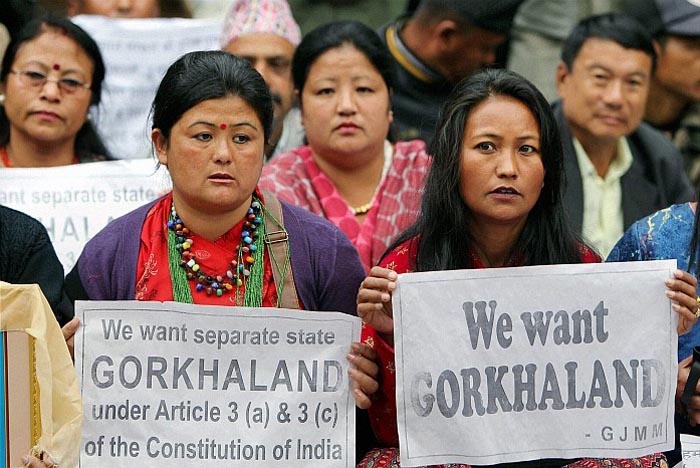Last year I had the pleasure of visiting two famous hill stations in India. In March I visited Sikkim while in November I visited Darjeeling. Although both were just 120 km apart, the difference in their overall infrastructure was humongous. While Gangtok the capital of Sikkim was incredibly beautiful and has rightly got the tag for the cleanest city in India, Darjeeling its more famous cousin was in complete shambles with poor roads, filthy streets and complete lack of development in every part of the city.
We should not forget, India has a population of 1250 million people and we have 29 states with us. That makes it an average of 43 million people per state. My opinion on an ideal size should be 10 million per state, which is still equivalent to Sweden, Israel, Norway and many other developed countries in the world. At 10 million population per state, India would have nearly 125 states, the demand for newer states is much less than that.
Let’s look at some of the valid points in support of the creation of Gorkhaland and the common criticisms against it:-
- A closer state capital: Gangtok is within 150 km from any town/village of Sikkim, which makes it very easy for common citizens to access the facilities that a state capital generally provides, for instance – Major Government facilities, High Courts and other economic benefits. Just think of a citizen in Kalimpong who has to travel more than 700 km to Kolkata. In Europe that is equivalent to crossing the border of 5 countries starting from the borders of Slovakia through Austria, Germany, Switzerland and then reaching France. How can common people get good governance ? Especially when accessibility is always a major factor in hilly terrains.
2. State Chief Minister: By being a small state, Gorkhaland will be able to select a chief minister who belongs to that region and will have a better grasp of the local problems. Plus local culture and traditions will also be much more highlighted.
3. Help in Policymaking: Kolkata lives in another world detached from the everyday problems of Infrastructure, Employment and Education in the lower belts of the Himalayas.
The broad scale policies of the West Bengal Government doesn’t necessarily fit the Hills. Separate states help to address this problem without having to worry about what’s going on in a city roughly a thousand Kms away from them.
4. Fodder to the Chickens neck: The Darjeeling-Kalimpong-Kurseong belt is not just any other place in the country. This region sits atop the ‘Chicken’s Neck’ or Siliguri Corridor and any law and order problem in this area can quickly spiral up to a separatist activity cutting off the entire northeast from the map of India. Continuous under development in this region compared to its northeastern peers acts as a fodder for separatist groups. We should not forget that this region was the starting point of violent Naxalite-Maoist movement which has killed thousands of people till date.
5. A more accessible Government: As governments tend to be responsible for fewer people they become more accessible. Parrikar, Raghubar Das, Manik Sarkar are good examples of this.
Due to accessibility, the smaller states generally outperform their bigger peers in most of the Human Development Index, Refer to these Wikipedia links:
https://en.wikipedia.org/…/List_of_Indian_states_and_territ…
https://en.wikipedia.org/…/Indian_states_ranking_by_literac…
Arguments against the division of West Bengal:-
- It will lead to a chain reaction which will weaken the country:
USA has 50 states to manage a population of 300 million people. We created a good number of states in the last 15-20 years including the latest Telangana but that did not weaken the country. On the contrary, we grew stronger. Old states like Bihar, Madhya Pradesh (which were often called BIMARU states) as well as their broken counterparts like Jharkhand, Chattisgarh both are growing parallelly. Similarly, the division of West Bengal will be more beneficial for Bengal as well as the new hilly state in northeast India.
2. More ethnic clashes:
People think there will be ethnic clashes similar in lines with the Telangana-AP controversy. Telangana was a rare case. We have created ample states after India’s independence and there was never any ethnic clashes for it. Same will happen for West Bengal-Gorkhaland
3. Increased administrative costs:
The cost in state assemblies is very little to even think about it. Smaller states will have small sets of Minister and MLAs so costs will be much lower. Just compare the assemblies of Goa with that of Maharashtra.
India is a gigantic country of 1250 million people and it can’t become developed with 70% of its people still living in villages. We are too dependent on too few cities and it becomes very tough for administrative forces to reach the hinterlands of our country.
At least Darjeeling needs an immediate attention, due to its security issues from neighbouring China and Bangladesh. The government of India should immediately create a new state with a new capital built from scratch in this region. With its small and lean structure, it can also form a jewel in India’s crown like its other northeastern sister states.
